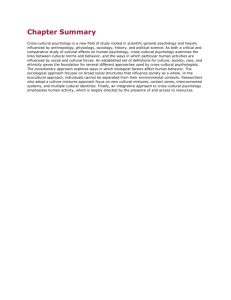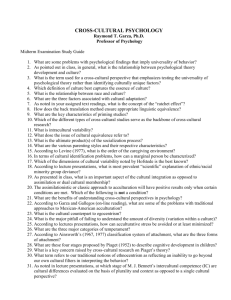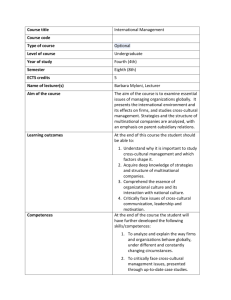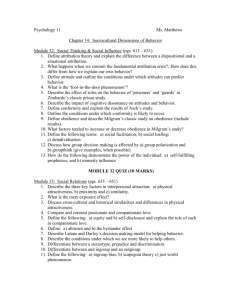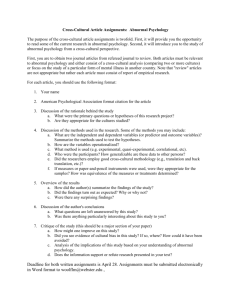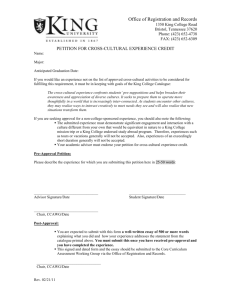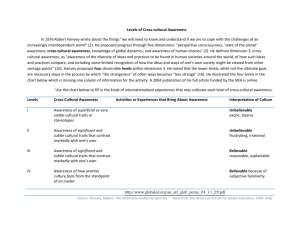Chapter 2. Methodology of Cross-Cultural Research
advertisement
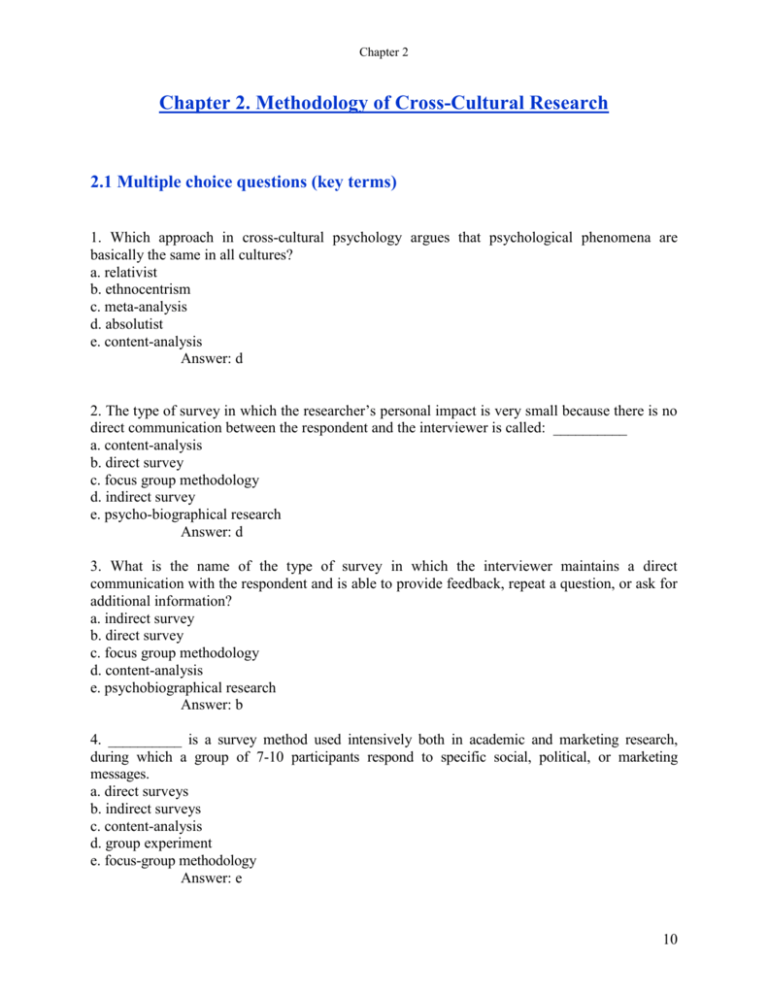
Chapter 2 Chapter 2. Methodology of Cross-Cultural Research 2.1 Multiple choice questions (key terms) 1. Which approach in cross-cultural psychology argues that psychological phenomena are basically the same in all cultures? a. relativist b. ethnocentrism c. meta-analysis d. absolutist e. content-analysis Answer: d 2. The type of survey in which the researcher’s personal impact is very small because there is no direct communication between the respondent and the interviewer is called: __________ a. content-analysis b. direct survey c. focus group methodology d. indirect survey e. psycho-biographical research Answer: d 3. What is the name of the type of survey in which the interviewer maintains a direct communication with the respondent and is able to provide feedback, repeat a question, or ask for additional information? a. indirect survey b. direct survey c. focus group methodology d. content-analysis e. psychobiographical research Answer: b 4. __________ is a survey method used intensively both in academic and marketing research, during which a group of 7-10 participants respond to specific social, political, or marketing messages. a. direct surveys b. indirect surveys c. content-analysis d. group experiment e. focus-group methodology Answer: e 10 Chapter 2 5. The strategy used to establish the applicability of research findings obtained in one country or culture to other countries or cultures is called the________. a. comparativists strategy b. meta-analysis strategy c. application-oriented strategy d. absolutist strategy e. direct strategy Answer: c 6. What is the name of the strategy that attempts to find similarities and differences in certain statistical measures in a sample of cultures? a. comparativists strategy b. indirect strategy c. application-oriented strategy d. absolutist approach e. content-analysis strategy Answer: a 7. A research method that systematically organizes and summarizes both the manifest and latent content of communication is called: a. survey b. focus-group methodology c. latent analysis d. content-analysis e. arrangement method Answer: d 8. Evidence that the methods selected for the study, measure the same phenomenon across other countries or cultures chosen for the study is called: a. correlation b. equivalence c. random sample d. comparativists strategy e. application-oriented strategy Answer: b 9. _______ is the method of observation that involves the recording of people’s behavior in an environment created by the researcher. a. laboratory observation b. content-analysis c. meta-analysis d. random sample e. naturalistic observation Answer: a 11 Chapter 2 10. What is the name for the quantitative analysis of a large collection of scientific results that attempts to make sense of a diverse selection of data? a. psychological analysis b. content-analysis c. meta-analysis d. indirect surveys e. laboratory observation Answer: c 11. ________ is a method observation that involves the recording of people’s behavior in their natural environments with little or no personal intervention. a. natural witness testimony b. content-analysis c. meta-analysis d. hidden-camera method e. naturalistic observation Answer: e 12. A longitudinal analysis of particular individuals, usually outstanding persons, celebrities, and leaders, representing different countries or cultures is called: a. investigative journalism b. sensationalism c. focus-group methodology d. psychobiographical research e. content-analysis Answer: d 13. The ________ is a view is cross-cultural psychology that asserts that psychological phenomena should be studies only from “within” the culture where these phenomena occur. a. internal investigation b. application-oriented strategy c. relativist approach d. cross-cultural approach e. absolutist approach Answer: c 14. A sample having characteristics that accurately reflect the characteristics of the population is called: a. representative sample b. reliable sample c. experimental sample d. survey sample e. convenience sample Answer: a 12 Chapter 2 15. What is the name for the investigative method in which groups of people answer questions about their opinions or their behavior? a. content-analysis b. survey c. psychobiographical research d. experiment e. representative sample Answer: b 2.2 Multiple choice questions (comprehension and application) 1. The established cross-cultural correlation linking an increase in poverty in a community or country to an increase in violent crime would be an example of a_________ correlation. a. positive b. high c. low d. negative e. high-low Answer: a Section: Quantitative Approach 2. A clinical psychologists writes the following: “Psychological symptoms are similar around the world. If you are anxious, you are restless, not focused, and very tense. Cultural differences in symptoms are insignificant.” This reflects which cross-cultural approach to comparing phenomena? a. relativist b. absolutist c. correlational d. systematic e. random Answer: b Section: Comparing Two Phenomena 3. A graduate student tells you that she is going to travel India to collect comparative data for her dissertation. She indicates that she has chosen this country because she was born there and believes she will have a relatively easy time finding a research sample. What type of sampling strategy is she employing? a. random sampling b. systematic sampling c. convenience sampling d. experimental sampling e. reliable sampling Answer: c Section: Sample Selection 13 Chapter 2 4. Which of the following is a description of a systematic sample in cross-cultural research? a. groups for this sample are selected according to an assumption or theory (for example, collectivist groups and individualist groups) b. groups for this sample are selected according to a systematic violation of a custom c. cultural groups for the research are selected randomly d. groups are selected so that each one represent one continent (Europe, Asia, Africa, America, and Australia) e. a sample including at least 3 countries Answer: a Section: Sample Selection 5. If the strength of an ethnic group’s religious beliefs are said to be positively correlated with their family values, which of the following statements is true? a. A influences B but not the other way around b. B influences A but not the other way around c. A and B may influence each other d. A and B are independent and do not influence each other e. all of the above Answer: c Section: Quantitative Approach 6. Thirteen exchange students received the following scores on a written aptitude test: 2, 5, 9, 3, 3, 4, 9, 6, 6, 9, 9,1, 1. What is the median score for this group? a. 2 b. 3 c. 4. d. 6. e. 5 Answer: e Section: Quantitative Research in Cross-Cultural Psychology 7. In traditional cross-cultural psychology, cultural dichotomies were used to compare and contrast: a. observation and experiment b. Western and non-Western cultures c. content-analysis and survey methods d. random and other types of sampling e. excellent and poor test translations Answer: b Section: Cultural Dichotomies 8. If you are conducting an experimental study assessing the impact of videos games upon the academic performance of Japanese and American students, the dependent variable is _________. a. number of hours spent on video games b. skill of video-game playing c. Japanese educational system d. grades at school e. U.S. educational system Answer: d Section: Experimental Studies 14 Chapter 2 9. When assessing abuse against women, which of the following statements best reflects the absolutist approach to cross-cultural studies? a. abuse is defined differently in various places; we should not judge it using our standards b. there should not be a cultural justification of abuse against women c. women are tolerant to abuse if they are in love with the abuser d. women should understand the context in which abuse takes place e. family members are mostly responsible for abuse against women Answer: b Section: Comparing two Phenomena 10. If you were to examine African and European fairy tales to find out how often they refer to symptoms of mental illness, what kind of a methodology are you likely to use? a. naturalistic observation b. experiment c. laboratory observation d. content-analysis e. sample selection Answer: d Section: Content-analysis 11. Divorce rates around the world are negatively correlated with fertility rates. This means that the more children a family has a. the greater chance of divorce b. the less chance of divorce c. the greater chance that the husband older that his wife d. the greater chance of family conflicts e. the greater chance of conflicts with in-laws Answer: b Section: Quantitative Approach 2.3 True/false questions 1. According to the absolutist approach in cross-cultural psychology, human behavior in its full complexity can be understood only within the context of the culture in which it occurs. Answer: F Section: Comparing Two Phenomena 2. A correlation establishes a cause-and-effect relationship between the variables. Answer: F Section: Quantitative Approach 3. Qualitative and quantitative methods are not mutually exclusive and in many cases psychologists choose both in their research. Answer: T Section: Qualitative Approach 4. A typical focus group in psychological research consists of 100 people. 15 Chapter 2 Answer: F Section: Focus-Group Methodology 5. One of the most serious weaknesses of the focus-groups methodology in cross-cultural research is that it typically relies on non-representative samples. Answer: T Section: Sample Selection 6. A procedure called back-translation used in cross-cultural surveys usually helps researchers to make sure that a translated version of a test (survey) is as close to the original as possible. Answer: T Section: A Hidden Obstacle of Cross-Cultural Studies 7. In a random sample, any country, a person, or group has an equal chance of being selected in the research sample. Answer: T Section: Sample Selection 8. The term, “point of critical distinction” refers to the manners with which a person criticizes other people. Answer: F Section: On Similarities and Differences 9. According to the study by Matsumoto (1992), individuals from homogeneous societies tend to detect and identify other people’s emotions less accurately than people from heterogeneous societies do. Answer: T Section: Avoiding Bias of Generalizations 10. Naturalistic observation refers to studies conducted in rural areas, away from large metropolitan cities. Answer: F Section: Observation in Cross-Cultural Psychology 11. In an experimental study designed to investigate academic skills, you ask students from five countries to complete a difficult computerized math test. This is an example of a focus-group methodology. Answer: F Section: Focus-Group Methodology 2.4. Short-answer questions 1. There are three basic measures of central tendency: the mode, the median, and_________. Answer: the mean Section: Quantitative Research in Cross-Cultural Psychology 2. In cross-cultural psychology the term “etic” refers to the absolutist approach, while the term “emic” refers to the_________. 16 Chapter 2 Answer: relativist approach Section: Comparing Two Phenomena 3. What type of measurement scale is being used in the following example: “Please rank order your favorite forms of transportation in New York City.” □ bus □ underground metro □ cab □ own car □ bike Answer: ordinal Section: Quantitative Approach: Measurement Scales 4. After developing a therapeutic technique for treating depression you decide that you want to determine its effectiveness cross-culturally. You are having difficulty choosing the countries for your sample. Your colleagues in Canada, Bulgaria, and China offer to help. This would be an example of what type of sampling strategy? Answer: convenience Section: Sample Selection 5. Imagine you have developed a test that measures a person “readiness” to get married and start a family. You find that the test is a good predictor of successful marriages. You then decide to pursue an application-oriented strategy. What are you trying to determine? Answer: try applicability in other countries Section: Major Steps for Preparation of a Cross-Cultural Study 6. If you created an experimental procedure to study the relationship between people’s body weight and the way they are treated by their peers, the independent variable in your experiment would be _____ Answer: body weight Section: Experimental Studies 7. What terms stands for “research of research in psychological studies?” Answer: meta-analysis Section: Meta-Analysis 8. What racial group has the highest median income per household? Answer: Asian (and Pacific Islander) Section: Quantitative Research 9. Cross-cultural researchers pursue four major goals: to describe, to explain, to control, and_________. 17 Chapter 2 Answer: to predict Section: Goals of Cross-Cultural Research 10. If you email you question to people in different countries but to not have an opportunity to communicate with them, what type of a survey are you conducting? Answer: indirect Section: Survey Methods 11. What is cultural response bias in surveys? Answer: the bias caused by the desire of participants to give culturallyappropriate answers Section: On Similarities and Differences 12. What is one of the most serious weaknesses of the focus-groups methodology in crosscultural research (this weakness is related to sample selection)? Answer: the sample is not representative Section: Focus Group Methodology 13. Which procedure used in cross-cultural surveys usually helps researchers to make sure that a translated version of a test (survey) is as close to the original as possible? Answer: Back translation Section: A Hidden Obstacle of Cross-Cultural Studies 2.5 Essay questions 1. Explain the concept of cultural dichotomies. Give examples. 2. Why should results of telephone (including cell phone) surveys in some countries be approached with caution? 3. Give an example of the comparativist strategy in cross-cultural research. 4. Describe the differences between the absolutist and relativist approaches in cross-cultural psychology. 5. How would you explain the point of critical distinction (PCD)? 6. Explain why the point of critical distinction (PCD) is thought of as a “conceptual fork” when comparing two phenomena. Why is this a useful conceptualization in the field of cross-cultural psychology? 18 Chapter 2 6. Name and describe the three steps that should be taken when translating a test (or survey) for a cross-cultural study. 7. Discuss the four recommendations made for assessing cross-cultural research. 8. One of the substantial weaknesses of cross-cultural research is its overwhelming reliance on research samples comprised of students. Why is it a weakness? 9. To receive reliable survey information in countries under authoritarian regimes can often be extremely difficult. Why? Give several reasons. 10. Studies show that people in countries such as Japan and Korea tend to evaluate themselves critically in surveys; they tend to consider self as not necessarily hard-working. Explain the reasons for such cultural response bias. 11. Consider a situation. As a psychologist, you have developed a test that measures a person’s “readiness” to get married and start a family. You find that the test is a fine predictor if a person could have a successful marriage. Next, you decide to pursue an application-oriented strategy for your test. What does it mean? What will you do? 19
